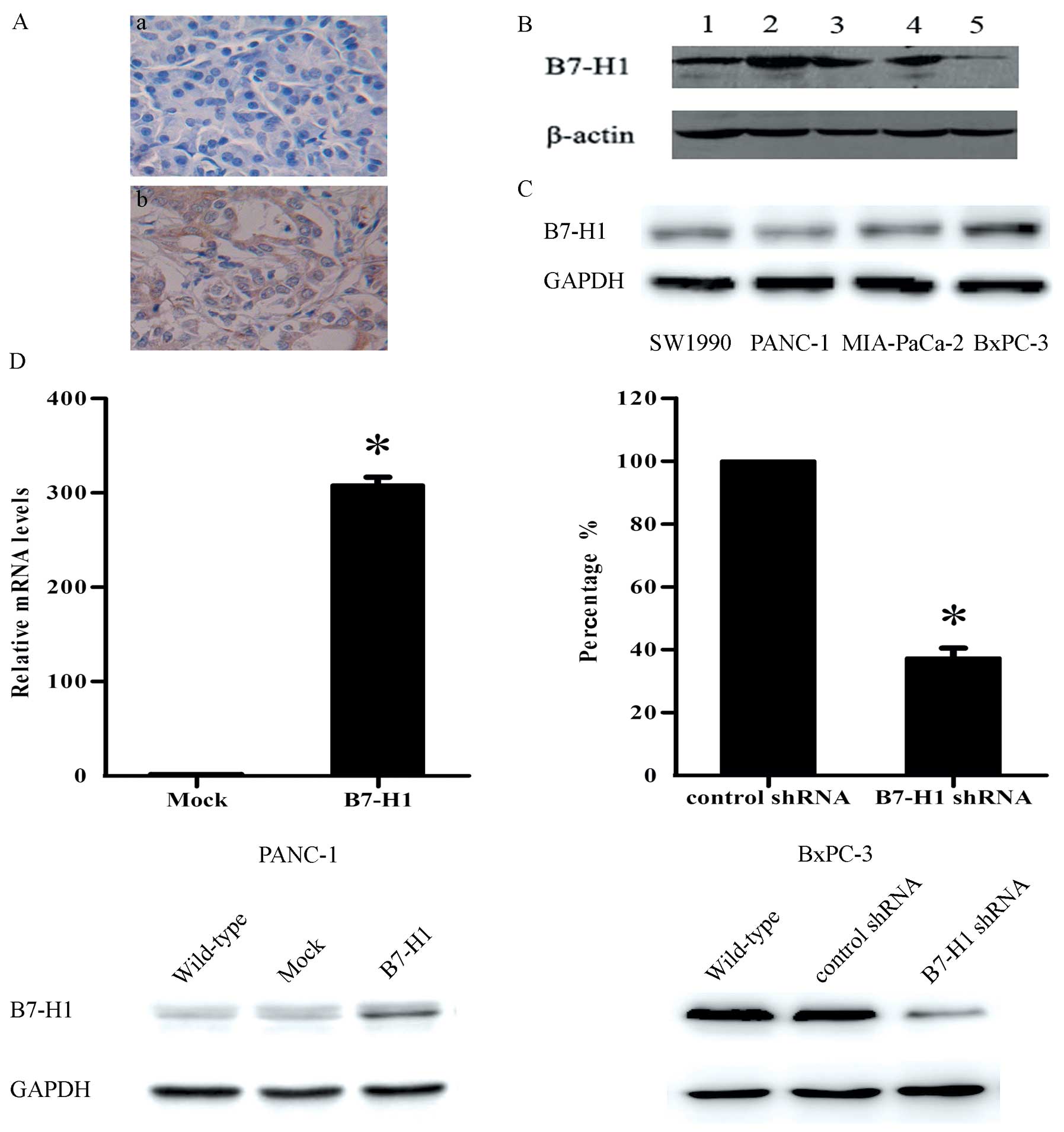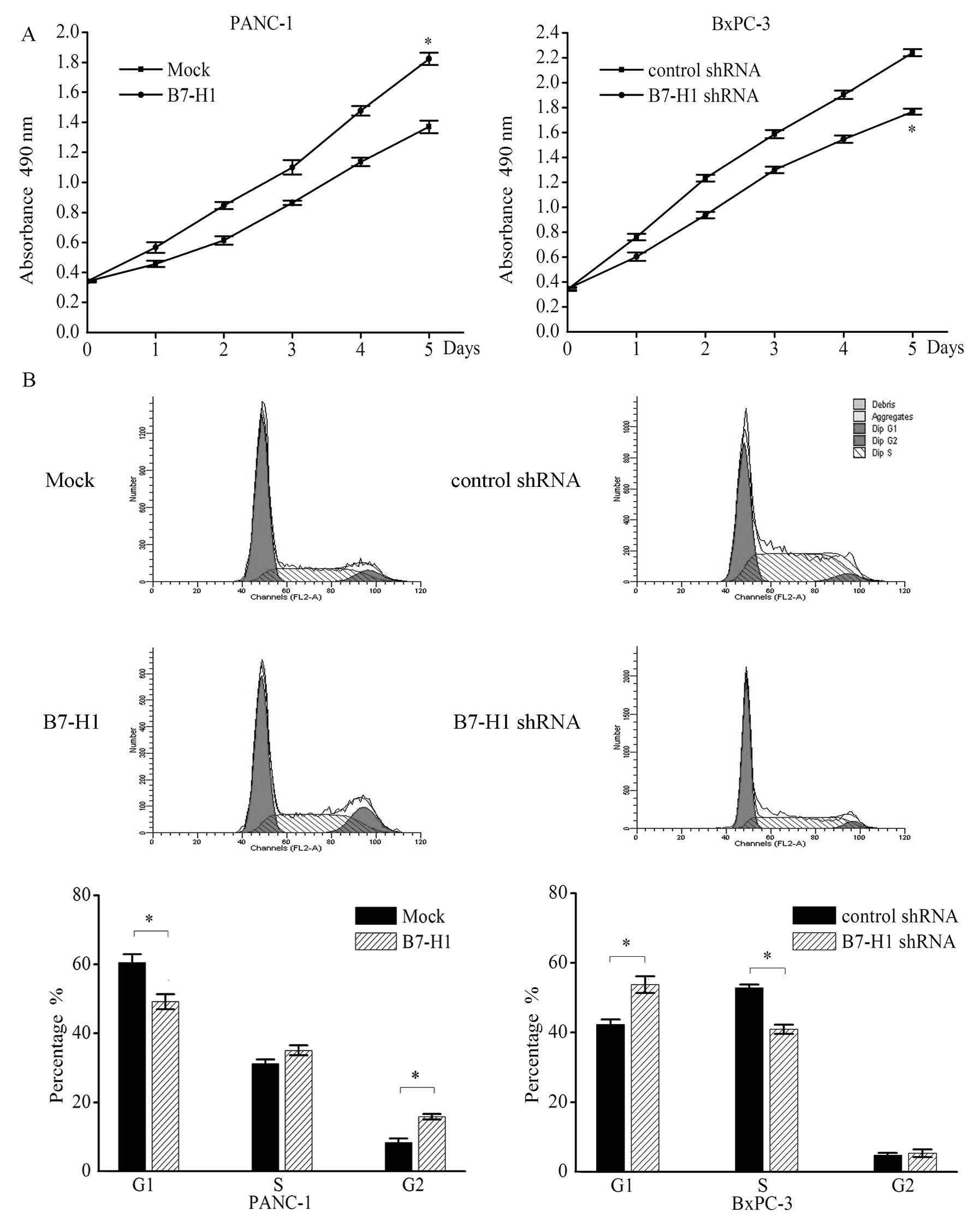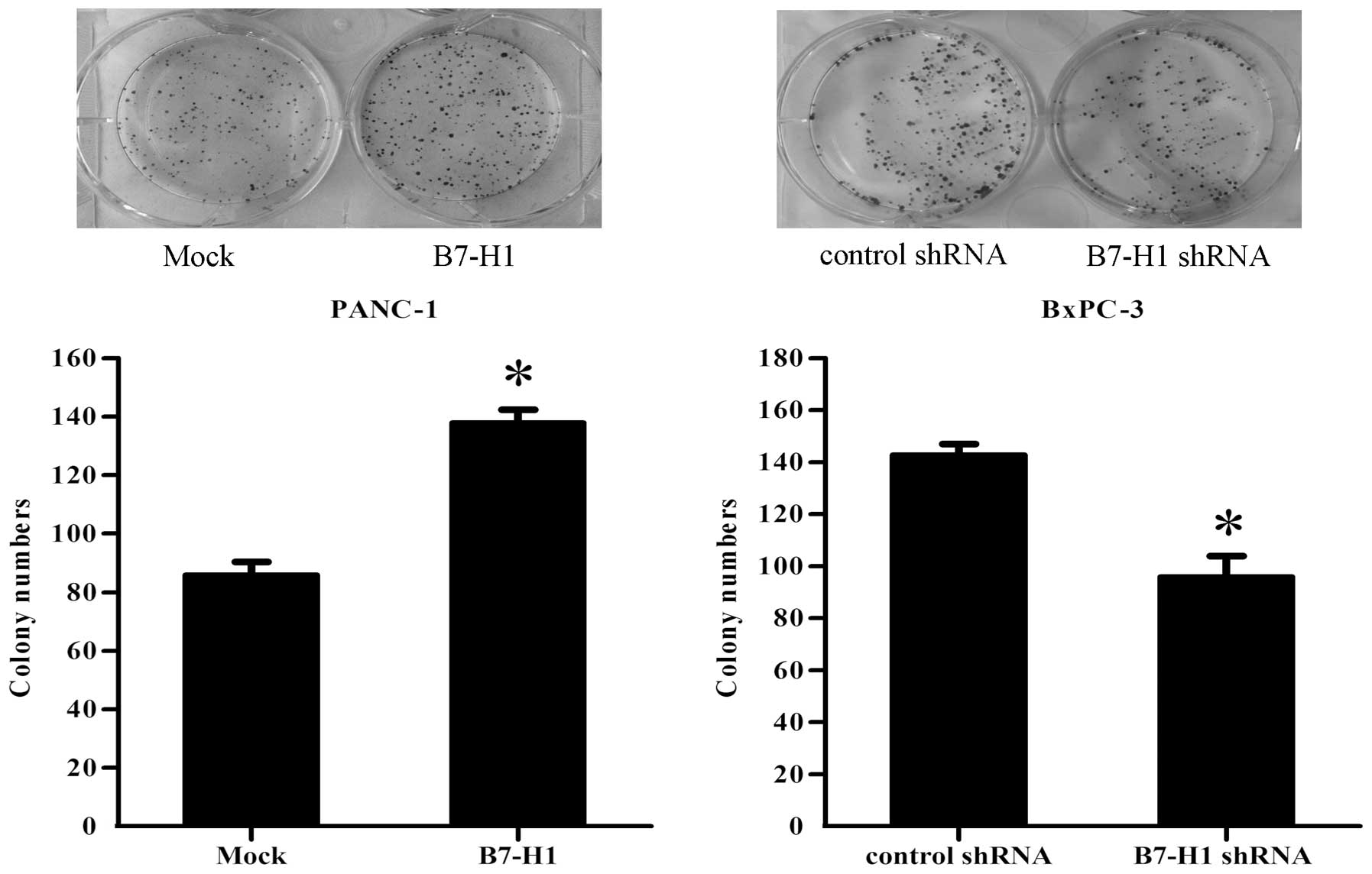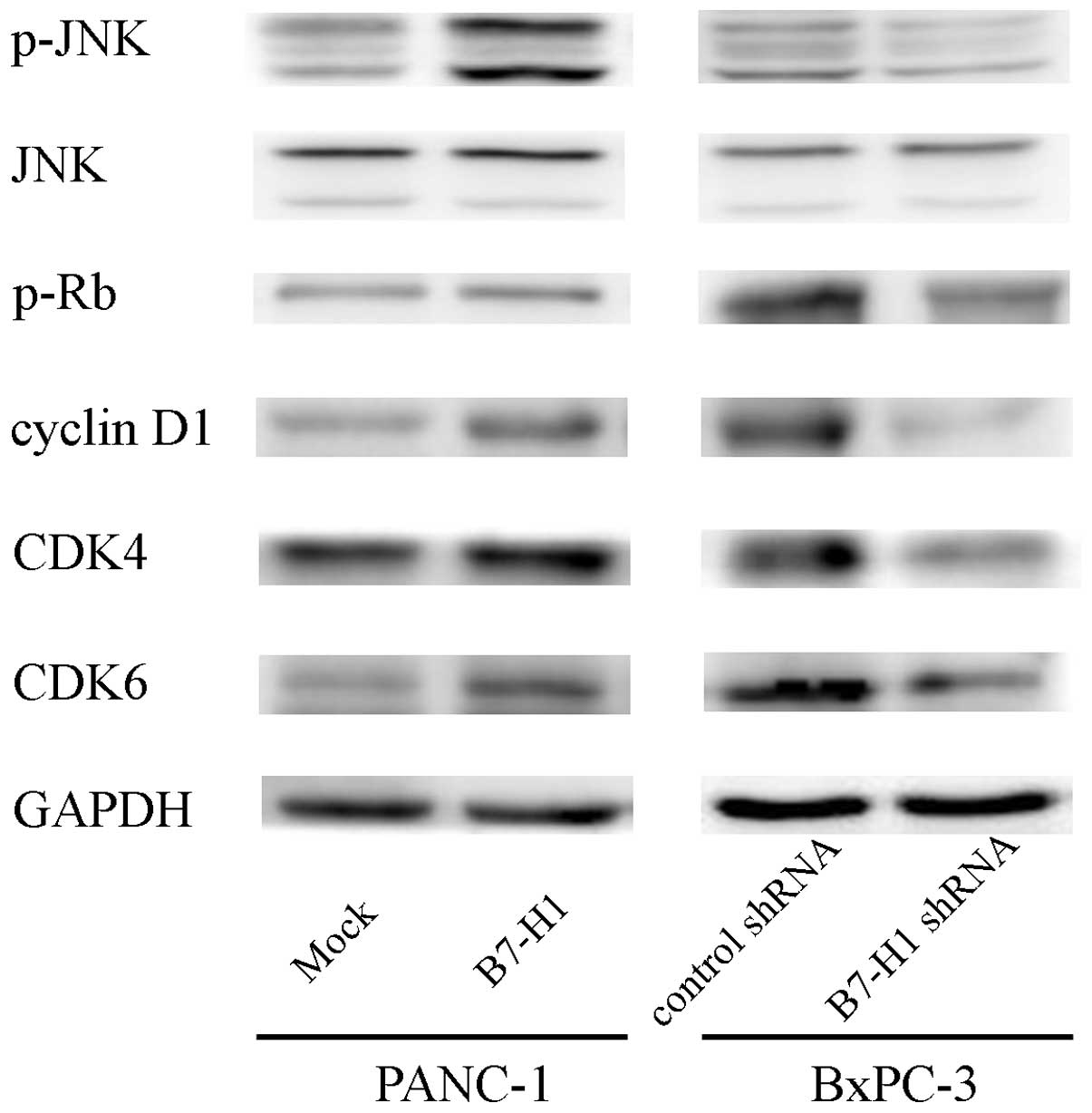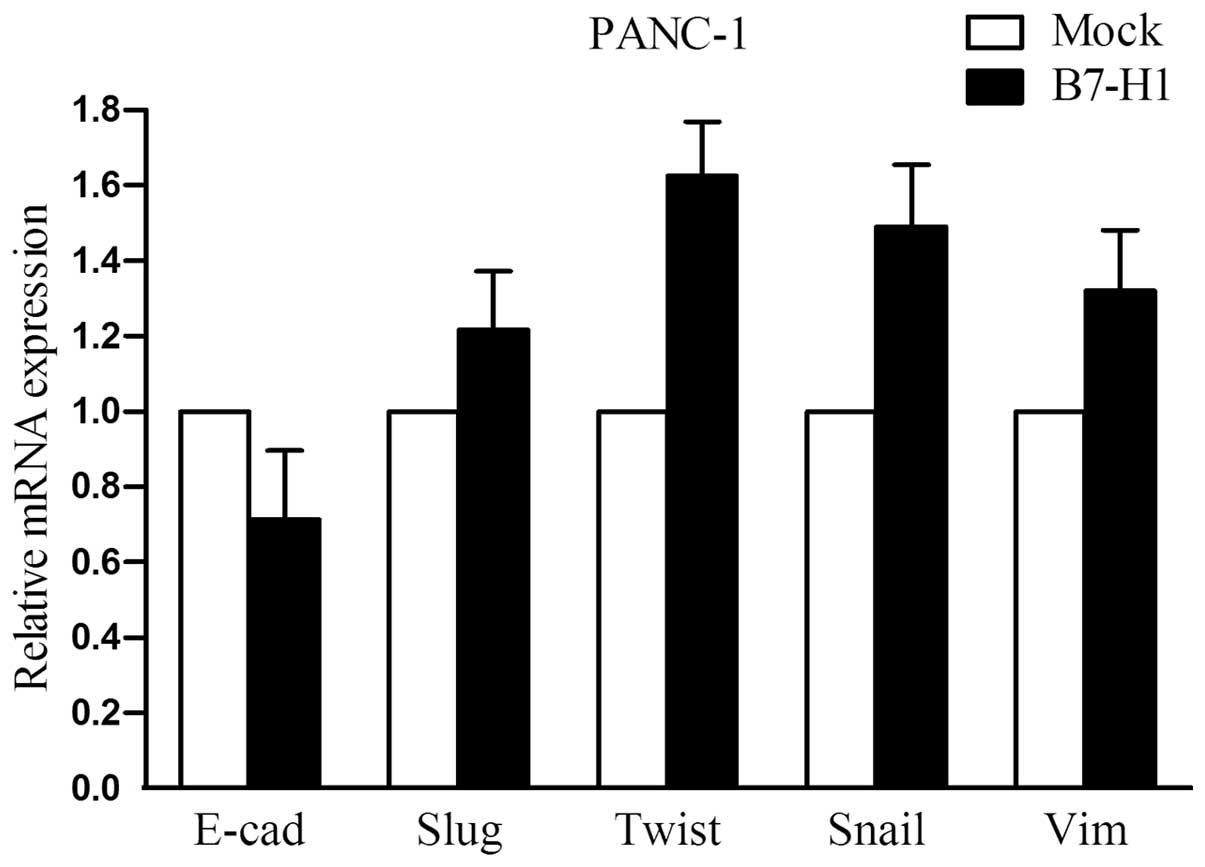Overexpression of B7-H1 correlates with malignant cell proliferation in pancreatic cancer
- Authors:
- Published online on: December 31, 2013 https://doi.org/10.3892/or.2013.2955
- Pages: 1191-1198
Abstract
Introduction
B7-H1 (CD274, PD-L1) is a cell-surface glycoprotein belonging to the B7 family of costimulatory molecules, which was first identified in 1999 (1). B7-H1 expression is found not only in antigen-presenting cells but also in activated T cells and in a number of tumour cells. Many studies have confirmed that B7-H1 is widely distributed in various types of human cancers, including melanoma, ovarian, colon and lung cancers (2), pancreatic (3), oesophageal (4), gastric carcinoma (5) and gliomas (6). Cancer cell-associated B7-H1 is closely correlated with poor prognosis and a higher grade of malignancy. Moreover, B7-H1 has been shown to be involved in the protection of cancer cells from activated tumour antigen-specific T lymphocytes through the induction of T lymphocyte anergy or apoptosis after ligation to the T lymphocyte receptor PD-1 or other receptors (7,8). In addition, B7-H1 expression is induced on the tumour cell surface by cytokines, such as interferon (IFN)-γ. The blockade of the B7-H1/PD-1 pathway by neutralising antibodies effectively enhances T lymphocyte responses against human cancer and reduces tumour growth (9–11). Thus, B7-H1/PD-1 interaction apparently regulates antitumour immunity.
However, other interpretations for this molecular function have been revealed by several recent studies. The expression of B7-H1 in breast cancer patients is directly associated with the proliferative Ki-67 marker, which is independent of the PD-1 expression in the host (12). A similar phenomenon was also found in myeloma cells (13). In addition, in skin carcinoma, B7-H1 was confirmed to regulate epithelial-mesenchymal transition (EMT) and to enhance carcinogenesis (14), and in mastocytoma cells, B7-H1 can act as a receptor to transmit a signal from T cells to tumour cells that leads to resistance to cell lysis (15). Moreover, our laboratory previously found that the PD-1/PD-L1 complex transfers a reverse signal to B7-H1+ pancreatic cancer cells upon drug-induced apoptosis in vitro (16). All of these results may indicate that B7-H1 not only mediates the inhibition of the activated T cell response by binding to PD-1; but also accelerates carcinogenesis in solid tumour cells.
Nevertheless, the roles of B7-H1 and the exact mechanism of action of this protein during cancer onset and progression are largely undefined. In particular, it is not known whether and how B7-H1 molecules play a role in the pathophysiology of pancreatic neoplasms. The current data suggest the use of tumour B7-H1 expression as a predictive biomarker. However, the designation of positive B7-H1 expression remains confounded by tumour heterogeneity, antibody diversity and assay variability. Therefore, in the present study, B7-H1 was overexpressed and depleted in several pancreatic cancer cell lines to investigate its effects on biological function and to elucidate the possible underlying mechanisms. These observations support the conclusion that B7-H1 may have effects on tumourigenesis in human pancreatic cancer and may be an effective therapeutic target for this deadly disease in the clinical setting.
Materials and methods
Patients and tissue samples
Pancreatic carcinoma specimens (histopathologically confirmed primary pancreatic duct adenocarcinomas) were surgically removed from 30 pancreatic carcinoma patients at Zhejiang Provincial People’s Hospital. Surgically resected pancreatic cancer specimens were stored at −80°C for protein extraction. Formalin-fixed and paraffin-embedded sections were used for immunohistochemical staining. Two healthy pancreas tissue samples obtained through an organ donor program were used as the controls in the present study which was approved by the local ethics committee. All patients in the study provided informed consent.
Immunohistochemical staining for B7-H1 expression in pancreatic carcinoma tissues
Paraffin-embedded 4-μm-thick tissue sections were dried for 40 min at 58°C, deparaffinised in xylene, and rehydrated through sequential incubation in EtOH/water solutions. The sections were treated with 3% hydrogen peroxide in methanol for 15 min at room temperature in the dark to quench the endogenous peroxidase activity. After rinsing in water and phosphate-buffered saline (PBS), the sections were blocked with serum (diluted 1:20 in PBS) from a non-immunised animal for 30 min to reduce non-specific binding. Subsequently, the sections were incubated with a primary monoclonal antibody against B7-H1 (R&D Systems; diluted 1:50 in PBS) in a moist chamber at 4°C overnight. After washing in PBS, biotinylated anti-mouse immunoglobulin (Dako) at a dilution of 1:200 was added for 45 min, and the sections were then washed and incubated with the ABC reagent (Strept ABC complex/HRP; Dako) for 45 min. The peroxidase reaction was developed with 0.02% 3,3′-diaminobenzidine tetrahydrochloride (Sigma, St. Louis, MO, USA) in PBS containing 0.06% hydrogen peroxide for 1 min. The sections were then rinsed with water and counterstained with Harris’ hematoxylin. Immunoreactivity in >10% of the cells in one field was defined as positive.
Cell lines and cultures
Four human pancreatic cancer cell lines (BxPC-3, MIA PaCa-2, SW1990 and PANC-1) and the human embryonic kidney cell line 293T were obtained from the American Type Culture Collection (ATCC; Manassas, VA, USA). The human pancreatic cancer cell lines were cultured in RPMI-1640 medium (Gibco, Carslbad, CA, USA) supplemented with 10% fetal bovine serum (FBS; Gibco) and antibiotics (100 μg/ml streptomycin and 100 IU/ml of penicillin) at 37°C in a humidified incubator containing 5% CO2. The 293T cells were maintained in high-glucose DMEM (Gibco) containing 10% FBS. The cells were grown on sterile tissue culture dishes and were passaged every two days using 0.25% trypsin (Invitrogen).
Generation of stable B7-H1-overexpressing and -silenced pancreatic cell lines
The complete cDNA sequence of the human B7-H1 was generated by PCR using 5′-GGAATTCAT GAGGATATTTGCTGTC-3′ as the forward primer and 5′-TT TGCGGCCGCTTACGTCTCCTCCA-3′ as the reverse primer. The sequence was then cloned into a pLenO-GTP plasmid (Invabio Biotechnology Ltd., Shanghai, China). The plasmids were sequenced with the primers to confirm the correctness of the constructed plasmid. An empty vector was used as a negative control. Replication-defective lentiviruses were produced by the transient transfection of 293T cells using Lipofectamine Plus (Invitrogen), pLenO-GTP-B7-H1, pRsv-REV, pMDlg-pRRE and pMD2G (Invabio Biotechnology Ltd). After transfection, samples of the viruses were harvested at 72 h and filtered through a Millex-HV 0.45-μm PVDF filter (Millipore, Billerica, MA, USA). The transduction of PANC-1 cells was performed by 6 h of exposure to dilutions of the viral supernatant in the presence of Polybrene (5 μg/ml). The stably transfected cells were selected by culture in puromycin (2 μg/ml).
To suppress B7-H1 expression, the shRNA-expressing pGPU6 lentivirus system was used (Shanghai GenePharma, Shanghai, China) to transfect the BxPC-3 cells. Briefly, the B7-H1 shRNA targeting sequence (B7-H1 shRNA) was 5′-GGATCCAGTCACCTCTGAACA-3′, and the negative control shRNA targeting sequence (control shRNA) was 5′-TTCTCCGAACGTGTCACGT-3′. Cells seeded in a 6-well culture plate were transfected with either B7-H1-shRNA or control-shRNA lentivirus according to the manufacturer’s protocol. The stable suppression of the target genes was achieved by the selection of cells in 1 mg/ml of G418 (Life Technologies).
Cell proliferation and colony formation assay
For the quantification of the cell viability, 3-(4,5-dimethylthiazol-2-yl)-5-(3-carboxy-methoxyphenyl)-2-(4-sulfophenyl)-2H-tetrazolium, inner salt (MTS) assays were performed according to the manufacturer’s instructions (CellTiter 96 AQueous Non-Radioactive Cell Proliferation assay; Promega, Madison, WI, USA). Briefly, the cells were plated in 96-well plates in medium containing 10% FBS at a density of ~3,000 cells/well. The absorbance was measured at 490 nm using a microtitration plate spectrophotometer.
For the colony formation assays, dissociated cells were planted into 6-cm cell culture dishes (100 cells/dish) and incubated for 12 days. The plates were washed with PBS and stained with Giemsa. The number of colonies consisting of >50 cells was counted.
Cell cycle analysis
The cells (5×105) were seeded into a 6-cm tissue culture dish. At the indicated time-points, the cells were harvested, fixed in 1% paraformaldehyde, washed with PBS, and stained with 5 mg/ml propidium iodide in PBS supplemented with RNase A (MultiSciences Biotech Co., Ltd., Hangzhou, China) for 30 min at room temperature. The stained cells were collected and analysed using BD flow cytometry systems.
Western blotting
The total protein from cultured cells was extracted in cell lysis buffer (Beyotime Institute of Biotechnology, Haimen, China) and quantified using the Bradford method. Proteins (40 μg) were loaded and separated on 10% SDS-PAGE. After the proteins were transferred to a polyvinylidene fluoride membrane (Millipore), the membrane was incubated overnight at 4°C with antibodies against B7-H1 (R&D Systems, Minneapolis, MN, USA), cyclin D1, p-Rb, CDK4, CDK6, phosphorylated extracellular signal-regulated kinase (p-ERK), ERK, phosphorylated c-Jun N-terminal protein kinase (p-JNK), JNK, phosphorylated p38 (p-p38), p38, β-actin and GAPDH (1:1,000; Cell Signaling Technology, Beverly, MA, USA). After incubation with peroxidase-conjugated anti-mouse or rabbit IgG (Santa Cruz Biotechnology) at 37°C for 2 h, the bound proteins were visualised using ECL and detected using the ImageQuant LAS 4000 (Fujifilm, Tokyo, Japan). The relative protein levels were calculated in reference to GAPDH as the loading control.
RNA extraction and quantitative real-time PCR
The total RNA was isolated from cultured cells using the TRIzol reagent (Invitrogen) according to the manufacturer’s recommended procedure. The reverse transcription of 1 μg of RNA was performed using the SuperRT Reverse Transcriptase reagent kit (Beijing CoWin Biotech Co., Ltd., Beijing, China) following the manufacturer’s instructions. The quantitative real-time PCR was performed in a total volume of 25 μl using the SYBR-Green PCR Master Mix and a 7500 Fast Real-Time PCR System (Applied Biosystems). The reaction conditions were as follows: 95°C for 10 min and 40 cycles of 95°C for 15 sec and 60°C for 1 min. A dissociation step was applied to generate a melting curve in order to confirm the specificity of the amplification. GAPDH transcripts were amplified and served as the reference. The relative levels of gene expression were represented as ΔCt = Ct(gene) - Ct(reference), and the fold-change of gene expression was calculated using the 2−ΔΔCt method. The experiments were performed in triplicate. The primer sequences are shown in Table I.
Statistical analysis
Each experiment was performed at least three times independently, and the data are presented as the means ± SD. The significance of the differences between the groups was judged using a two-tailed Student’s t-test. All of the tests were considered significant if the P-value was <0.05.
Results
B7-H1 expression is upregulated in pancreatic carcinoma specimens
Previous research has revealed that the expression of B7-H1 is increased in a variety of human tumours. In the present study, a similar increase in B7-H1 expression was detected in pancreatic carcinoma. The immunohistochemical analysis showed that 62.4±9.1% of the tumour samples expressed B7-H1 and that this protein was primarily located in the cytoplasm of the tumour cells (Fig. 1A). The western blot analysis further confirmed these results (Fig. 1B).
Expression of B7-H1 in human pancreatic cancer cell lines
We detected the B7-H1 expression levels in four human pancreatic cancer cell lines by western blot analysis (Fig. 1C). To explore whether B7-H1 plays a functional role in pancreatic tumour cell behaviour in vitro, we chose to use BxPC-3 and PANC-1 cells in the experiments. The two cell lines were genetically altered to express different B7-H1 levels, as shown in Fig. 1D, to determine the effect of B7-H1 on tumour cell growth.
B7-H1 regulates cell proliferation, cell cycle distribution and colony formation in pancreatic cancer cell lines in vitro
To determine whether the overexpression of the B7-H1 gene affects the behaviour of pancreatic tumour cells in vitro, the growth curve, cell cycle distribution and colony formation were examined in cell lines that were genetically altered to express different B7-H1 levels (Fig. 2). Compared with the mock-transfected cells (Mock), the PANC-1 cells transfected with the B7-H1 vector (B7-H1) exhibited an increased cell growth rate on day 7. On day 5 the absorbance of the B7-H1-overexpressing cells was >32.8% of that of the mock-transfected cells. In contrast, knockdown of B7-H1 in BxPC-3 cells (B7-H1 shRNA) reduced the proliferation relative to the cells transfected with a negative control shRNA (control shRNA; Fig. 2A).
In addition, results of the flow cytometry for the cell cycle analysis confirmed the effect of B7-H1 on pancreatic tumour cells. We found that the percentage of cells in the G1 phase was significantly decreased in the B7-H1-overexpressing PANC-1 cells (Mock vs. B7-H1, 60.5±2.4 vs. 49.2±2.2%) and was significantly increased in the B7-H1-depleted BxPC-3 cells (control shRNA vs. B7-H1 shRNA, 42.3±1.4 vs. 53.8±2.4%), whereas the percentage of cells in the S phase was increased in the B7-H1-overexpressing PANC-1 cells (Mock vs. B7-H1, 31.2±1.2 vs. 35.1±1.4%) and was significantly decreased in the B7-H1-depleted BXPC-3 cells (control shRNA vs. B7-H1 shRNA, 52.9±0.9 vs. 40.9±1.3%; Fig. 2B). In addition, the percentage of cells in the G2 phase was significantly increased in the B7-H1-overexpressing cells (Mock vs. B7-H1, 8.3±1.2 vs. 15.8±0.8%).
Finally, to document the ability of the different groups of pancreatic cancer cells to form colonies, single-cell suspensions were plated in 6-cm culture dishes at a density of 100 cells/dish. After 12 days, as shown in Fig. 3, the PANC-1 cells transfected with the B7-H1 vector (B7-H1) exhibited a significant increase in the colony formation numbers by 60%, when compared with the control (Mock). However, the knockdown of B7-H1 in BxPC-3 cells (B7-H1 shRNA) resulted in a reduction of 32% in the ability of the cells to form colonies compared with the cells transfected with the control shRNA.
B7-H1 overexpression upregulates cyclin D1 and p-JNK in pancreatic cancer cells
To investigate the possible mechanisms through which B7-H1 affects pancreatic cancer cell proliferation, we tested the effects of B7-H1 overexpression and knockdown on various cell cycle-related proteins related to cell proliferation. As shown in Fig. 4, B7-H1 overexpression caused the upregulation of cyclin D1, CDK4/6 and Rb phosphorylation. Furthermore, we explored the phosphorylation of the mitogen-activated protein kinase (MAPK) signalling molecules (ERK, JNK and p38) and found that the phosphorylation level of JNK was increased, which may indicate that this protein is involved in the process through which B7-H1 affects cell growth. In contrast, B7-H1 depletion reduced cyclin D1, CDK4/6, p-Rb and p-JNK expression. Together, these results suggest that B7-H1 affects cell cycle progression likely by regulating cyclin D1 and p-JNK expression in pancreatic cancer cells.
EMT-related molecules are not markedly altered in B7-H1- overexpressing cells
To address the impact of B7-H1 on cellular epithelial-mesenchymal transition (EMT), we explored the expression of several important EMT-related molecules in B7-H1-overexpressing PANC-1 cells. As shown in Fig. 5, the mRNA levels of E-cadherin, Slug, Twist, Snail and Vimentin were examined by quantitative real-time RT-PCR. However, we did not observe any marked changes in their expression.
Discussion
In the present study, we demonstrated that the B7-H1 expression level is upregulated in pancreatic carcinoma tissues and is a regulatory element in pancreatic tumour cell growth. The proliferation of pancreatic tumour cells was promoted in the B7-H1-overexpressing cell line, and the downregulation of B7-H1 by shRNA in a pancreatic cancer cell line with high constitutive B7-H1 expression decreased cell growth. In addition, the upregulation of cyclin D1 by B7-H1 overexpression was, at least in part, due to an increase in the phosphorylation level of the JNK pathway. We extended the results of previous studies; and further demonstrated that the high expression of B7-H1 in pancreatic cancer cells exhibits an intrinsic proliferative advantage in vitro.
Due to a lack of effective therapies, pancreatic cancer is one of the most aggressive and intractable human malignant tumours. Therefore, novel approaches against this lethal disease need to be established to improve patient prognosis. Among the proposed novel therapies, immunotherapy may be a potent strategy. B7-H1, a member of the B7 family of proteins, is upregulated in many tumours, including pancreatic cancer and confers resistance to cytolysis by CD8+ cytolytic T cells (CTLs) to allow cancer cells to escape the immune surveillance of the host (2). In addition, its expression is strongly associated with patient clinicopathological parameters (3,11). In pancreatic carcinoma, immunohistochemical staining revealed that B7-H1 and IL-10 are almost completely expressed in tumour cells. B7-H1 expression is significantly associated with poor tumour differentiation and advanced tumour stage (17). Ample evidence demonstrates that B7-H1 acts as a ligand for programmed death receptor-1 (PD-1), and that their binding delivers an inhibitory signal to T cells that induces apoptosis, anergy and exhaustion (18–20). The ablation of the B7-H1 and PD-1 interaction by neutralising antibodies could restore the CTL-mediated lysis of tumour cells in vitro, which suggests that the B7-H1/PD-1 interaction forms a barrier between tumour cells and CTLs (15). Recent studies, however, have revealed that B7-H1 exhibits other molecular shield phenomena. For instance, B7-H1 is a ubiquitous antiapoptotic receptor in mastocytoma cells and exhibits greater proliferative capacity in B7-H1+ MDS blasts than in B7-H1− MDS blasts (15,21,22). Our previous study also showed that B7-H1 transduces an antiapoptotic signal and that the formation of the PD-1/PD-L1 complex inhibits drug-induced apoptosis in pancreatic cancer cells in vitro (16). Accordingly, in the present study, we used PANC-1 cells that were stably transfected with B7-H1 and B7-H1-knockdown BxPC-3 cells to explore the effect of B7-H1 on cell growth. Our results indicated that B7-H1 indeed affected pancreatic cancer tumourigenesis and cell cycle progression. Furthermore, the knockdown of B7-H1 decreased the protein levels of cyclin D1 and p-Rb, and B7-H1 overexpression increased cyclin D1 and p-Rb expression. Cyclin D1 was found to interact with CDK4/6 to elicit its function. The cyclin D-CDK4/6 complex partially phosphorylates Rb, which is important for cell cycle progression (23). All of these data suggest that B7-H1 may be involved in early-stage carcinogenesis through intrinsic cell changes before its binding to PD-1 or other receptors to downregulate active tumour immunity. This finding is consistent with our previous reports, which suggest that the upregulation of B7-H1 expression in human pancreatic carcinoma tissues may play a role in tumour progression and invasiveness. Thus, B7-H1 may be an effective therapeutic target for pancreatic cancer in the clinical setting.
As the B7-H1/PD-1 pathway plays an important role in the evasion of the host antitumour immune response, immunotherapies that regulate this pathway are expected to be beneficial. Initial clinical studies of antibodies directed against PD-1 and B7-H1 have shown marked antitumour activity in subsets of patients with malignancies (24,25). In pancreatic ductal adenocarcinoma, the blocking of B7-H1 increased the proliferation and function of tumour-specific CTLs at the tumour sites. However, the function of B7-H1 may not only be associated with the downregulation of T-cell function. One study indicated that B7-H1 molecules in myeloma cells exhibit dual activity; the induction of T-cell downregulation and the enhancement of aggressive myeloma cell characteristics, including increased proliferative ability and drug resistance. Thus, the blocking of the signal to T cells alone may be insufficient (13). In our experiment, B7-H1 molecules in pancreatic tumour cells were also associated with aggressive cell behaviour, including increased proliferative potential and resistance to drug-induced apoptosis. Thus, this finding must be taken into account when designing clinical trials targeting B7-H1.
Previous research has identified a mechanism that links the loss of the tumour suppressor ‘phosphatase and tensin homologue on chromosome ten’ (PTEN) with immunoresistance, mediated in part by B7-H1 (26). Thus, we tested the expression of PTEN in B7-H1-overexpressing pancreatic tumour cells and found no obvious difference (data not shown). Another study reported that squamous cell carcinomas induced in B7-H1 transgenic mice exhibited a loss of E-cadherin and the elevated expression of the transcription factors Slug and Twist, which drive the epithelial-mesenchymal transition (EMT) process (14). In the present study, the mRNA expression levels of E-cadherin, Slug, Twist, Snail and Vimentin were found to be comparable between the control and the B7-H1-overexpressing pancreatic cancer cells (Fig. 5). It is possible that B7-H1 overexpression in different tissues can produce different effects on tumour cell characteristics or that posttranscriptional regulation of relevant gene expression occurs. To summarise, these results suggest that the overexpression of B7-H1 in pancreatic tumour cells does not lead to cell EMT and PTEN expression changes.
Although several studies using different types of carcinomas have demonstrated that an elevated level of B7-H1 is highly correlated with tumour cell proliferation, antiapoptosis and EMT, the precise signalling involved in the B7-H1-mediated intrinsic cell changes remain largely undefined (2,12,13). Since B7-H1 most likely has another unidentified receptor, it may receive a proliferative signal by interacting with this receptor. Another possible mechanism is that B7-H1 molecules may not transmit any signal to tumour cells; but may coincidentally link with the activation of proliferative signals. In the present study, we showed that B7-H1 induced both cyclin D1 and phospho-JNK expression, which suggests that the upregulation of cyclin D1 by B7-H1 overexpression was likely through the JNK pathway. JNK signalling is reported to play an important role in pancreatic cancer cell proliferation (27). Further studies, including in vivo experiments and the in situ detection of cell cycle-related molecules and B7-H1 expression in human pancreatic tumour samples, are required.
In conclusion, the B7-H1 expression level was upregulated in pancreatic carcinoma tissues and the overexpression of B7-H1 accelerated pancreatic tumour cell proliferation. Our data provide a deeper understanding of B7-H1 function, namely, the promotion of pancreatic cell growth by facilitating cell cycle progression through the JNK-mediated upregulation of cyclin D1. These results suggest that B7-H1 functions as a positive regulator of pancreatic cancer proliferation.
Acknowledgements
The present study was supported by the Key Social Development Project of Major Science and Technology (2011C13036-1). All research was performed in the Biomedical Research Center, Zhejiang Provincial People’s Hospital, Hangzhou, China.
References
|
Dong H, Zhu G, Tamada K and Chen L: B7-H1, a third member of the B7 family, co-stimulates T-cell proliferation and interleukin-10 secretion. Nat Med. 5:1365–1369. 1999. View Article : Google Scholar : PubMed/NCBI | |
|
Dong H, Strome SE, Salomao DR, et al: Tumor-associated B7-H1 promotes T-cell apoptosis: a potential mechanism of immune evasion. Nat Med. 8:793–800. 2002. View Article : Google Scholar : PubMed/NCBI | |
|
Nomi T, Sho M, Akahori T, et al: Clinical significance and therapeutic potential of the programmed death-1 ligand/programmed death-1 pathway in human pancreatic cancer. Clin Cancer Res. 13:2151–2157. 2007. View Article : Google Scholar : PubMed/NCBI | |
|
Ohigashi Y, Sho M, Yamada Y, et al: Clinical significance of programmed death-1 ligand-1 and programmed death-1 ligand-2 expression in human esophageal cancer. Clin Cancer Res. 11:2947–2953. 2005. View Article : Google Scholar : PubMed/NCBI | |
|
Chen XL, Cao XD, Kang AJ, Wang KM, Su BS and Wang YL: In situ expression and significance of B7 costimulatory molecules within tissues of human gastric carcinoma. World J Gastroenterol. 9:1370–1373. 2003. | |
|
Wintterle S, Schreiner B, Mitsdoerffer M, et al: Expression of the B7-related molecule B7-H1 by glioma cells: a potential mechanism of immune paralysis. Cancer Res. 63:7462–7467. 2003.PubMed/NCBI | |
|
Dong H and Chen L: B7-H1 pathway and its role in the evasion of tumor immunity. J Mol Med. 81:281–287. 2003.PubMed/NCBI | |
|
Iwai Y, Ishida M, Tanaka Y, Okazaki T, Honjo T and Minato N: Involvement of PD-L1 on tumor cells in the escape from host immune system and tumor immunotherapy by PD-L1 blockade. Proc Natl Acad Sci USA. 99:12293–12297. 2002. View Article : Google Scholar : PubMed/NCBI | |
|
Flies DB, Sandler BJ, Sznol M and Chen L: Blockade of the B7-H1/PD-1 pathway for cancer immunotherapy. Yale J Biol Med. 84:409–421. 2011.PubMed/NCBI | |
|
Okudaira K, Hokari R, Tsuzuki Y, et al: Blockade of B7-H1 or B7-DC induces an anti-tumor effect in a mouse pancreatic cancer model. Int J Oncol. 35:741–749. 2009.PubMed/NCBI | |
|
Sznol M and Chen L: Antagonist antibodies to PD-1 and B7-H1 (PD-L1) in the treatment of advanced human cancer. Clin Cancer Res. 19:1021–1034. 2013. View Article : Google Scholar | |
|
Ghebeh H, Tulbah A, Mohammed S, et al: Expression of B7-H1 in breast cancer patients is strongly associated with high proliferative Ki-67-expressing tumor cells. Int J Cancer. 121:751–758. 2007. View Article : Google Scholar : PubMed/NCBI | |
|
Tamura H, Ishibashi M, Yamashita T, et al: Marrow stromal cells induce B7-H1 expression on myeloma cells, generating aggressive characteristics in multiple myeloma. Leukemia. 27:464–472. 2013. View Article : Google Scholar : PubMed/NCBI | |
|
Cao Y, Zhang L, Kamimura Y, et al: B7-H1 overexpression regulates epithelial-mesenchymal transition and accelerates carcinogenesis in skin. Cancer Res. 71:1235–1243. 2011. View Article : Google Scholar : PubMed/NCBI | |
|
Azuma T, Yao S, Zhu G, Flies AS, Flies SJ and Chen L: B7-H1 is a ubiquitous antiapoptotic receptor on cancer cells. Blood. 111:3635–3643. 2008. View Article : Google Scholar : PubMed/NCBI | |
|
Wang F, Ma J, Liu J, Jin H and Huang D: Synthetic small peptides acting on B7H1 enhance apoptosis in pancreatic cancer cells. Mol Med Rep. 6:553–557. 2012.PubMed/NCBI | |
|
Geng L, Huang D, Liu J, et al: B7-H1 up-regulated expression in human pancreatic carcinoma tissue associates with tumor progression. J Cancer Res Clin Oncol. 134:1021–1027. 2008. View Article : Google Scholar : PubMed/NCBI | |
|
Tsushima F, Yao S, Shin T, et al: Interaction between B7-H1 and PD-1 determines initiation and reversal of T-cell anergy. Blood. 110:180–185. 2007. View Article : Google Scholar : PubMed/NCBI | |
|
Goldberg MV, Maris CH, Hipkiss EL, et al: Role of PD-1 and its ligand, B7-H1, in early fate decisions of CD8 T cells. Blood. 110:186–192. 2007. View Article : Google Scholar : PubMed/NCBI | |
|
Okazaki T and Honjo T: The PD-1-PD-L pathway in immunological tolerance. Trends Immunol. 27:195–201. 2006. View Article : Google Scholar : PubMed/NCBI | |
|
Kondo A, Yamashita T, Tamura H, et al: Interferon-γ and tumor necrosis factor-α induce an immunoinhibitory molecule, B7-H1, via nuclear factor-κB activation in blasts in myelodysplastic syndromes. Blood. 116:1124–1131. 2010. | |
|
Ghebeh H, Lehe C, Barhoush E, et al: Doxorubicin downregulates cell surface B7-H1 expression and upregulates its nuclear expression in breast cancer cells: role of B7-H1 as an anti-apoptotic molecule. Breast Cancer Res. 12:R482010. View Article : Google Scholar : PubMed/NCBI | |
|
Knudsen KE, Diehl JA, Haiman CA and Knudsen ES: Cyclin D1: polymorphism, aberrant splicing and cancer risk. Oncogene. 25:1620–1628. 2006. View Article : Google Scholar : PubMed/NCBI | |
|
Brahmer JR, Drake CG, Wollner I, et al: Phase I study of single-agent anti-programmed death-1 (MDX-1106) in refractory solid tumors: safety, clinical activity, pharmacodynamics, and immunologic correlates. J Clin Oncol. 28:3167–3175. 2010. View Article : Google Scholar | |
|
Brahmer JR, Tykodi SS, Chow LQ, et al: Safety and activity of anti-PD-L1 antibody in patients with advanced cancer. N Engl J Med. 366:2455–2465. 2012. View Article : Google Scholar : PubMed/NCBI | |
|
Parsa AT, Waldron JS, Panner A, et al: Loss of tumor suppressor PTEN function increases B7-H1 expression and immunoresistance in glioma. Nat Med. 13:84–88. 2007. View Article : Google Scholar : PubMed/NCBI | |
|
Takahashi R, Hirata Y, Sakitani K, et al: Therapeutic effect of c-Jun N-terminal kinase inhibition on pancreatic cancer. Cancer Sci. 104:337–344. 2013. View Article : Google Scholar : PubMed/NCBI |



